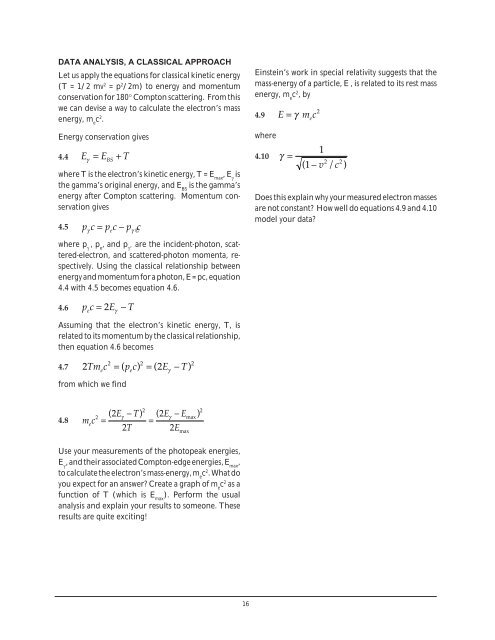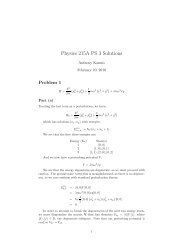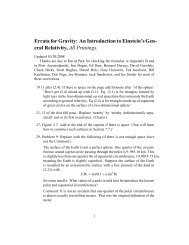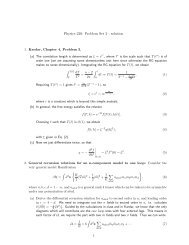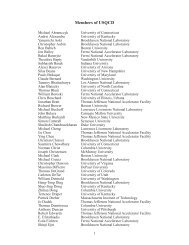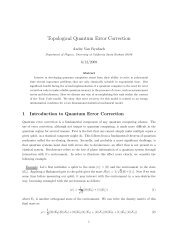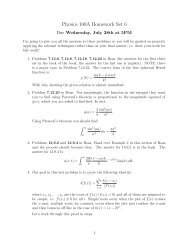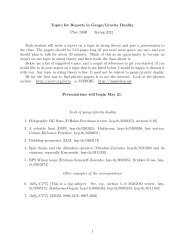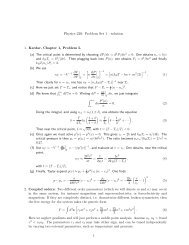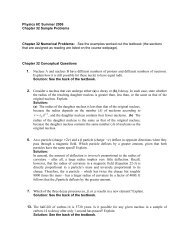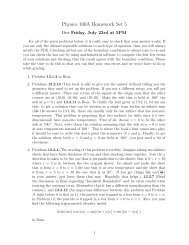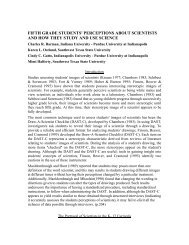Nuclear Spectroscopy
Nuclear Spectroscopy
Nuclear Spectroscopy
You also want an ePaper? Increase the reach of your titles
YUMPU automatically turns print PDFs into web optimized ePapers that Google loves.
DATA ANALYSIS, A CLASSICAL APPROACH<br />
Let us apply the equations for classical kinetic energy<br />
(T = 1/2 mv 2 = p 2 /2m) to energy and momentum<br />
conservation for 180° Compton scattering. From this<br />
we can devise a way to calculate the electron’s mass<br />
energy, m e<br />
c 2 .<br />
Energy conservation gives<br />
4.4<br />
Eγ = EBS<br />
+ T<br />
where T is the electron’s kinetic energy, T = E max<br />
, E γ<br />
is<br />
the gamma’s original energy, and E BS<br />
is the gamma’s<br />
energy after Compton scattering. Momentum conservation<br />
gives<br />
4.5 pc<br />
γ<br />
= pc<br />
e<br />
− pγ<br />
©<br />
c<br />
where p γ<br />
, p e<br />
, and p γ ’<br />
are the incident-photon, scattered-electron,<br />
and scattered-photon momenta, respectively.<br />
Using the classical relationship between<br />
energy and momentum for a photon, E = pc, equation<br />
4.4 with 4.5 becomes equation 4.6.<br />
Einstein’s work in special relativity suggests that the<br />
mass-energy of a particle, E , is related to its rest mass<br />
energy, m e<br />
c 2 , by<br />
4.9<br />
where<br />
4.10<br />
E= γ<br />
γ =<br />
m c e<br />
2<br />
1<br />
2 2<br />
( 1 − v / c )<br />
Does this explain why your measured electron masses<br />
are not constant? How well do equations 4.9 and 4.10<br />
model your data?<br />
4.6<br />
pc<br />
e<br />
= 2E γ<br />
−T<br />
Assuming that the electron’s kinetic energy, T, is<br />
related to its momentum by the classical relationship,<br />
then equation 4.6 becomes<br />
4.7<br />
2Tm c = ( p c) = ( 2E −T)<br />
2 2 2<br />
e e<br />
γ<br />
from which we find<br />
4.8<br />
mc<br />
e<br />
2<br />
( 2Eγ<br />
− T) ( 2Eγ<br />
− Emax)<br />
= =<br />
2T<br />
2E<br />
2 2<br />
max<br />
Use your measurements of the photopeak energies,<br />
E γ<br />
, and their associated Compton-edge energies, E max<br />
,<br />
to calculate the electron’s mass-energy, m e<br />
c 2 . What do<br />
you expect for an answer? Create a graph of m e<br />
c 2 as a<br />
function of T (which is E max<br />
). Perform the usual<br />
analysis and explain your results to someone. These<br />
results are quite exciting!<br />
16


